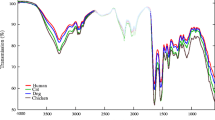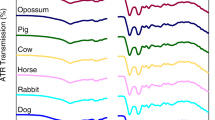Abstract
Blood species identification is an important challenge in forensic science. Conventional methods used for blood species analysis are destructive and associated with time-consuming sample preparation steps. Nuclear magnetic resonance (NMR) spectroscopy is known for its nondestructive properties and fast results. This research study presents a proton (1H) NMR method to discriminate blood species including human, cat, dog, elephant, and bison. Characteristic signals acting as markers are observed for each species. Moreover, the data are evaluated by principle component analysis (PCA) and support vector machines (SVM). A 100% correct species recognition between human and nonhuman species is achieved using radial basis kernel function (RBF) and standardized data. The research study shows that 1H NMR spectroscopy is a powerful tool for differentiating human and nonhuman blood showing a great significance to forensic science.







Similar content being viewed by others
References
Filippo B, Simon WL, Berti A, Miskelly GM, Lago G (2007) Forensic application of the luminol reaction as a presumptive test for latent blood detection. Talanta 72:896–913
Becker RF, Dutelle AW (2013) Criminal Investigation. Jones & Bartlett Learning, Burlingtion, MA, pp. 93–94
Kanthaswamy S, Premasuthan A, Ng J, Goyal V (2011) Quantitative real-time PCR (qPCR) assay for human-dog-cat species identification and nuclear DNA quantification. Forensic Sci Int: Genetics 6:290–295
Jackson ARW, Jackson JM (2008) Forensic science, 2nd edn. Pearson Education Limited, England, pp. 119–121
Bell S (2008) Encyclopedia of forensic science, revised edn. Facts On File, Inc., New York, pp. 205–209
Yamamoto Y, Tsutsumi A, Ishizu H (1989) Species identification of blood and bloodstains by enzyme-linked immunosorbent assay (ELISA) using anti-human immunoglobulin kappa light chain monoclonal antibody. Forensic Sci Int 40:85–89
Quarino L, Kobilinsky L (1988) Development of a radioimmunoassay technique for the detection of human hemoglobin in dried bloodstains. J Forensic Sci 33:1369–1378
James SH, Nordby JJ, Bell S (2014) Forensic science: an introduction to scientific and investigative techniques. CRC Press, Boca Raton, FL, pp. 205–228
Li R (2008) Forensic biology. CRC Press, Boca Raton, FL, pp. 104–113
Inouel H, Takabe F, Takenaka O, Iwasa M, Maeno Y (1990) Species identification of blood and bloodstains by high-performance liquid chromatography. Int J Legal Med 104:9–12
Espinoza EO, Lindley NC, Gordon KM, Ekhoff JA, Kirms MA (1999) Electrospray ionization mass spectrometric analysis of blood for differentiation of species. Anal Biochem 268:252–261
Fujihara J, Fujita Y, Yamamoto T, Nishimoto N, Kimura-Kataoka K, Kurata S, et al. (2016) Blood identification and discrimination between human and nonhuman blood using portable Raman spectroscopy. Int J Legal Med, online
Zhang L, Zhang S, Sun M, Wang Z, Li H, Li Y et al (2016) Blood species identification using near-infrared diffuse transmitted spectra and PLS-DA method. Infrared Phys Technol 76:587–591
Diehl BWK, Holzgrabe U (1999) Analysis of drugs. In: Holzgrabe U, Wawer I, Diehl BWK (eds) NMR spectroscopy in drug development and analysis. Wiley-VCH, Weinheim, pp. 16–60
Holzgrabe U (1999) NMR of body fluids. In: Holzgrabe U, Wawer I, Diehl BWK (eds) NMR spectroscopy in drug development and analysis. Wiley-VCH, Weinheim, pp. 118–133
Emwas AHM, Merzaban JS, Serrai H (2015) Theory and applications of NMR-based metabolomics in human disease diagnosis. In: Rahman A. Choudhary MI, Applications of NMR Spectroscopy, Elsevier, pp. 93–130
Zailer E, Diehl BWK (2016) Alternative determination of blood alcohol concentration by 1H NMR spectroscopy. J Pharm Biomed Anal 119:59–64
Noble WS (2006) What is a support vector machine? Nat Biotechnol 24:1565–1567
Bah CSF, Bekhit AEA, Carne A, McConnell MA (2013) Slaughterhouse blood: an emerging source of bioactive compounds. Compr Rev Food Sci Food Saf 12:314–331
Horn M, Kadgien M, Schnackerz K, Neubauer S (2000) 31P-nuclear magnetic resonance spectroscopy of blood: a species comparison. J Cardiovasc Magn Reson 2:143–149
Epinoza EO, Lindley NC, Gordon KM, Ekhoff JA, Kirms MA (1999) Electrospray ionization mass spectrometric analysis of blood for differentiation of species. Anal Biochem 268:252–261
Mistek E, Lednev IK (2015) Identification of species’ blood by attenuated total reflection (ATR) Fourier transform infrared (FT-IR) spectroscopy. Anal Bioanal Chem 407:7435–7442
Acknowledgements
We wish to thank Dr. vet. med. Olaf Behlert, Zoo Cologne, and Dr. Ansgar Waldmann, veterinary practice of Dr. Ansgar Waldmann, for supplying us with the animal blood samples. Y. Monakhova acknowledges funding in the framework of the state contract 4.1708.2014K of the Russian Ministry of Education.
Author information
Authors and Affiliations
Corresponding author
Rights and permissions
About this article
Cite this article
Zailer, E., Diehl, B.W.K. & Monakhova, Y.B. Blood species discrimination using proton nuclear magnetic resonance spectroscopy. Int J Legal Med 131, 723–729 (2017). https://doi.org/10.1007/s00414-016-1500-7
Received:
Accepted:
Published:
Issue Date:
DOI: https://doi.org/10.1007/s00414-016-1500-7




